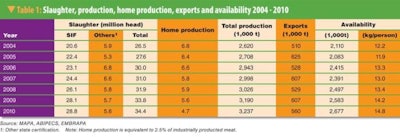
Sales by Brazil’s pig producers were worth US$1.34 billion in 2010, a 9.32% increase on the US1.23 billion recorded the year before. By volume, however, sales fell by 11.04% from 607,500 tons in 2009 to 540,400 thousand tons.
Brazilian pig meat producers and exporters association, Abipecs, notes that the year was characterized by producers having to adjust supply to changes in external demand and strong competition on international markets a strong expansion in consumption on the home market.
Exports
The financial crisis of 2008-2009 continued to affect the price and volumes of Brazil’s exports. While prices on international markets developed favourably – 22.9% higher than those achieved in 2009 – they remained below levels achieved over the period January to October 2008, before the crisis set in.
While there may have been some recovery in prices, Brazilian exports were hampered by a rising currency, which reduced the competitiveness of exports, particularly against major competitors such as the US and some European countries. Nevertheless, late last year Abipecs president Pedro de Camargo Neto commented that the country’s exports would tripe over the next 10 years.
Home market
For almost all sectors of the Brazilian economy, the home market in 2011, selling on the home market was much more attractive than exporting. This gave companies that had traditionally worked in export markets the option to reject international prices and take up more profitable offers from the home market.
By volume, total production in 2010 grew by 1.5% in comparison with 2009, rising from 3.19 million tons to 3.24 million tons. The main contributor to this growth was an increase in slaughter weight. Those pigs slaughtered through the SIF, the federal inspection, registered an average increase in weight of 3.5%. By head, the number of animals slaughtered was more or less stable at 34.4 million head. Abipecs reports that the number of breeding sows remained stable, at some 2.45 million head. While this was a slight increase on 2009, Abipecs notes that this was due to a lack of investment in the prior year.
The supply of pigs slaughtered in 2010 rose by 1.8% from 33.8 million head. Those slaughtered under the SIF scheme reached 28.8 million head, an increase of 2.5%, while those recorded under other schemes continued to fall. Meat from more than 83% of animals slaughtered went for home consumption.
The home market was characterized last year but low stocks, strong demand and high prices. In addition, there was a reduced supply of beef, resulting in consumers having to look to alternatives. Availability of pig meat on the home market grew by 4%. However, supplies remained below the market’s potential to consume, Abipecs believes, which it estimates at 15kg per person.
Feed association Sindiracoes estimates that the total amount of feed consumed by the pig industry last year stood at 15.3 million tons. Over the period January to October, the pig industry consumed some 12.6 million tons of feed.
Brazilian producers are expecting 2011 to be similar to 2010 in most respects, with the exception of production costs and greater access to export markets. On the negative side, rising grain prices will reduce margins. However, on a more positive note, the opening of the US market to exports from the state of Santa Catarina is expected to have follow on benefits, not only with the other members of the North American Free Trade Agreement, but also with Japan, South Korea, the EU and China.
Santa Catarina was recognized as free from foot and mouth disease in May 2007, and in October last year, Abpics announced that this status had been recognized by the US’ Animal and Plant Health Inspection Service, APHIS.


















